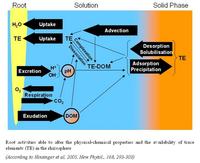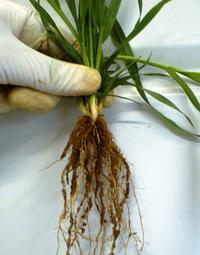Basic research on the rhizosphere
Studying the rhizosphere and its physico-chemical properties is paramount for determining the phytoavailability of trace elements in soil.
The rhizosphere is generally defined as the volume of soil surrounding the living roots of plants. The physical, physico-chemical and biological properties of the rhizosphere are greatly influenced by root activities. The spatial extension of the rhizosphere is highly dependent on the processes studied, so that it can vary from a sub-micrometre to a supra-centimetre scale [1].
Changes in the physico-chemical properties of the rhizosphere compared to those of non‑rhizosphere soil notably involve the pH, oxido-reduction potential and organic matter dissolved in the soil solution. These parameters greatly determine the speciation of trace elements in solutions.
Studying the rhizosphere and its physico-chemical properties is therefore paramount for determining the availability of trace elements in the rhizosphere and ultimately understand the bio-geochemical determinants of their phytoavailability.
It is relatively difficult to collect and study the rhizosphere in situ. It is therefore necessary to use specific techniques that reproduce the properties of the rhizosphere in experimental designs under controlled conditions. Among these, the root mat technique has been and remains widely used [2]. It is this technique that is brought into play for the RHIZOtest.
1. Hinsinger P, Bengough AG, Vetterlein D et Young IM 2009 Rhizosphere: biophysics, biogeochemistry and ecological relevance. Plant Soil, 321, 117-152.
2. Luster J, Göttlein A, Nowack B et Sarret G 2009 Sampling, defining, characterizing and modeling the rhizosphere – the soil science tool box. Plant Soil, 321, 457-482.


